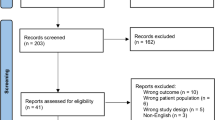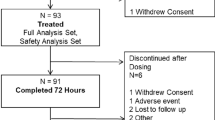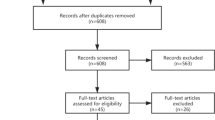Abstract
Purpose
Pain management after total knee arthroplasty (TKA) should permit early knee mobilization with minimal pain. Periarticular injection (PAI) with local anaesthetics has been recently discussed as a protocol of pain control. The purpose of this review of the literature was to evaluate the efficacy of PAI in comparison with femoral nerve block (FNB).
Methods
A literature search was performed in PubMed, EMBASE, the OVID database and the Cochrane Library databases. Risk of bias was assessed using the Cochrane collaboration tool. Outcomes of interest included narcotic consumption, pain score, early mobilization ability, length of stay and adverse effects or events.
Results
Research identified 918 articles, of which six with a total of 284 knees, met the inclusion criteria and were eligible for the current study. Conflicting evidence was found in terms of narcotic consumption on the postoperative day 1 and early mobilization ability. Total narcotic consumption, pain score in the first 2 days after surgery, length of stay and adverse effects or events showed no difference between two groups. Lower pain score on the day of surgery was detected after PAI. When compared to continuous FNB, patients in PAI group showed a tendency to achieving better ability of early mobilization.
Conclusions
In consideration of its relatively simple practice and its potential in analgesic effects or early mobilization ability, PAI had superiority to FNB in the management of pain control after TKA. Before PAI could be widely used in clinical practice after TKAs, further investigations would be necessary to confirm or refute our observed results and to unify the protocol of PAI.
Level of evidence
I.

Similar content being viewed by others
References
Abdallah FW, Brull R (2011) Is sciatic nerve block advantageous when combined with femoral nerve block for postoperative analgesia following total knee arthroplasty? A systematic review. Reg Anesth Pain Med 36(5):493–498
Affas F, Nygårds EB, Stiller CO, Wretenberg P, Olofsson C (2011) Pain control after total knee arthroplasty: a randomized trial comparing local infiltration anesthesia and continuous femoral block. Acta Orthop 82(4):441–447
Albrecht E, Morfey D, Chan V, Gandhi R, Koshkin A, Chin KJ, Robinson S, Frascarolo P, Brull R (2014) Single-injection or continuous femoral nerve block for total knee arthroplasty? Clin Orthop Relat Res 472(5):1384–1393
American Society of Anesthesiologists Task Force on Acute Pain Management (2004) Practice guidelines for acute pain management in the perioperative setting: an updated report by the American society of anesthesiologists task force on acute pain management. Anesthesiology 100(6):1573–1581
Andersen LØ, Husted H, Otte KS, Kristensen BB, Kehlet H (2008) High-volume infiltration analgesia in total knee arthroplasty: a randomized, double-blind, placebo-controlled trial. Acta Anaesthesiol Scand 52(10):1331–1335
Ashraf A, Raut VV, Canty SJ, McLauchlan GJ (2013) Pain control after primary total knee replacement. A prospective randomised controlled trial of local infiltration versus single shot femoral nerve block. Knee 20(5):324–327
Capdevila X, Barthelet Y, Biboulet P, Ryckwaert Y, Rubenovitch J, d’Athis F (1999) Effects of perioperative analgesic technique on the surgical outcome and duration of rehabilitation after major knee surgery. Anesthesiology 91(1):8–15
Carli F, Clemente A, Asenjo JF, Kim DJ, Mistraletti G, Gomarasca M, Morabito A, Tanzer M (2010) Analgesia and functional outcome after total knee arthroplasty: periarticular infiltration versus continuous femoral nerve block. Br J Anaesth 105(2):185–195
Chaumeron A, Audy D, Drolet P, Lavigne M, Vendittoli PA (2013) Periarticular injection in knee arthroplasty improves quadriceps function. Clin Orthop Relat Res 471(7):2284–2295
Chelly JE, Ben-David B, Williams BA, Kentor ML (2003) Anesthesia and postoperative analgesia: outcomes following orthopedic surgery. Orthopedics 26(8 Suppl):s865–s871
Cheville A, Chen A, Oster G, McGarry L, Narcessian E (2001) A randomized trial of controlled-release oxycodone during inpatient rehabilitation following unilateral total knee arthroplasty. J Bone Jt Surg Am 83(4):572–576
Coley KC, Williams BA, DaPos SV, Chen C, Smith RB (2002) Retrospective evaluation of unanticipated admissions and readmissions after same day surgery and associated costs. J Clin Anesth 14(5):349–353
Cook P, Stevens J, Gaudron C (2003) Comparing the effects of femoral nerve block versus femoral and sciatic nerve block on pain and opiate consumption after total knee arthroplasty. J Arthroplasty 18(5):583–586
Essving P, Axelsson K, Kjellberg J, Wallgren O, Gupta A, Lundin A (2010) Reduced morphine consumption and pain intensity with local infiltration analgesia (LIA) following total knee arthroplasty. Acta Orthop 81(3):354–360
Feibel RJ, Dervin GF, Kim PR, Beaulé PE (2009) Major complications associated with femoral nerve catheters for knee arthroplasty: a word of caution. J Arthroplasty 24(6 Suppl):132–137
Forst J, Wolff S, Thamm P, Forst R (1999) Pain therapy following joint replacement: a randomized study of patient-controlled analgesia versus conventional pain therapy. Arch Orthop Trauma Surg 119(5–6):267–270
Higgins JP, Altman DG, Gøtzsche PC, üni P, Moher D, Oxman AD, Savovic J, Schulz KF, Weeks L, Sterne JA, Cochrane Bias Methods Group; Cochrane Statistical Methods Group (2011) The cochrane collaboration’s tool for assessing risk of bias in randomised trials. BMJ 343:d5928
Horlocker TT, Cabanela ME, Wedel DJ (1994) Does postoperative epidural analgesia increase the risk of peroneal nerve palsy after total knee arthroplasty? Anesth Analg 79(3):495–500
Horlocker TT, Hebl JR, Kinney MA, Cabanela ME (2002) Opioid-free analgesia following total knee arthroplasty: a multimodal approach using continuous lumbar plexus (psoas compartment) block, acetaminophen, and ketorolac. Reg Anesth Pain Med 27(1):105–108
Hunt KJ, Bourne MH, Mariani EM (2009) Single-injection femoral and sciatic nerve blocks for pain control after total knee arthroplasty. J Arthroplasty 24(4):533–538
Ilfeld BM, Morey TE, Wang RD, Enneking FK (2002) Continuous popliteal sciatic nerve block for postoperative pain control at home: a randomized, double-blinded, placebo-controlled study. Anesthesiology 97(4):959–965
Kelley TC, Adams MJ, Mulliken BD, Dalury DF (2013) Efficacy of multimodal perioperative analgesia protocol with periarticular medication injection in total knee arthroplasty: a randomized, double-blinded study. J Arthroplasty 28(8):1274–1277
Kerr DR, Kohan L (2008) Local infiltration analgesia: a technique for the control of acute postoperative pain following knee and hip surgery: a case study of 325 patients. Acta Orthop 79(2):174–183
Lareau JM, Robbins CE, Talmo CT, Mehio AK, Puri L, Bono JV (2012) Complications of femoral nerve blockade in total knee arthroplasty and strategies to reduce patient risk. J Arthroplasty 27(4):564–568
Lombardi AV Jr, Berend KR, Mallory TH, Dodds KL, Adams JB (2004) Soft tissue and intraarticular injection of bupivacaine, epinephrine, and morphine has a beneficial effect after total knee arthroplasty. Clin Orthop Relat Res 428:125–130
Marino J, Russo J, Kenny M, Herenstein R, Livote E, Chelly JE (2009) Continuous lumbar plexus block for postoperative pain control after total hip arthroplasty. A randomized controlled trial. J Bone Jt Surg Am 91(1):29–37
Modig J, Borg T, Karlström G, Maripuu E, Sahlstedt B (1983) Thromboembolism after total hip replacement: role of epidural and general anesthesia. Anesth Analg 62(2):174–180
Moghtadaei M, Farahini H, Faiz SH, Mokarami F, Safari S (2014) Pain management for total knee arthroplasty: single-Injection femoral nerve block versus local infiltration analgesia. Iran Red Crescent Med J 16(1):e13247
Morrison RS, Magaziner J, McLaughlin MA, Orosz G, Silberzweig SB, Koval KJ, Siu AL (2003) The impact of post-operative pain on outcomes following hip fracture. Pain 103(3):303–311
Mullaji A, Kanna R, Shetty GM, Chavda V, Singh DP (2010) Efficacy of periarticular injection of bupivacaine, fentanyl, and methylprednisolone in total knee arthroplasty: a prospective, randomized trial. J Arthroplasty 25(6):851–857
Ng FY, Ng JK, Chiu KY, Yan CH, Chan CW (2012) Multimodal periarticular injection versus continuous femoral nerve block after total knee arthroplasty: a prospective, crossover, randomized clinical trial. J Arthroplasty 27(6):1234–1238
Parvataneni HK, Shah VP, Howard H, Cole N, Ranawat AS, Ranawat CS (2007) Controlling pain after total hip and knee arthroplasty using a multimodal protocol with local periarticular injections: a prospective randomized study. J Arthroplasty 22(6 Suppl 2):33–38
Paul JE, Arya A, Hurlburt L, Cheng J, Thabane L, Tidy A, Murthy Y (2010) Femoral nerve block improves analgesia outcomes after total knee arthroplasty: a meta-analysis of randomized controlled trials. Anesthesiology 113(5):1144–1162
Raj PP, Knarr DC, Vigdorth E, Denson DD, Pither CE, Hartrick CT, Hopson CN, Edström HH (1987) Comparison of continuous epidural infusion of a local anesthetic and administration of systemic narcotics in the management of pain after total knee replacement. Anesth Analg 66(5):401–406
Ranawat CS, Ranawat AS, Mehta A (2003) Total knee arthroplasty rehabilitation protocol: What makes the difference? J Arthroplasty 18(3 Suppl 1):27–30
Rodgers A, Walker N, Schug S, McKee A, Kehlet H, van Zundert A, Sage D, Futter M, Saville G, Clark T, MacMahon S (2000) Reduction of postoperative mortality and morbidity with epidural or spinal anaesthesia: results from overview of randomised trials. BMJ 321(7275):1493
Sharma S, Iorio R, Specht LM, Davies-Lepie S, Healy WL (2010) Complications of femoral nerve block for total knee arthroplasty. Clin Orthop Relat Res 468(1):135–140
Singelyn FJ, Deyaert M, Joris D, Pendeville E, Gouverneur JM (1998) Effects of intravenous patient-controlled analgesia with morphine, continuous epidural analgesia, and continuous three-in-one block on postoperative pain and knee rehabilitation after unilateral total knee arthroplasty. Anesth Analg 87(1):88–92
Spangehl MJ, Clarke HD, Hentz JG, Misra L, Blocher JL, Seamans DP (2015) The Chitranjan Ranawat award periarticular injections and femoral and sciatic blocks provide similar pain relief after TKA: a randomized clinical trial. Clin Orthop Relat Res 473(1):45–53
Strassels SA, Chen C, Carr DB (2002) Postoperative analgesia: economics, resource use, and patient satisfaction in an urban teaching hospital. Anesth Analg 94(1):130–137
Tammachote N, Kanitnate S, Manuwong S, Yakumpor T, Panichkul P (2013) Is pain after TKA better with periarticular injection or intrathecal morphine? Clin Orthop Relat Res 471(6):1992–1999
Teng Y, Jiang J, Chen S, Zhao L, Cui Z, Khan MS, Du W, Gao X, Wang J, Xia Y (2014) Periarticular multimodal drug injection in total knee arthroplasty. Knee Surg Sports Traumatol Arthrosc 22(8):1949–1957
Toftdahl K, Nikolajsen L, Haraldsted V, Madsen F, Tønnesen EK, Søballe K (2007) Comparison of peri- and intraarticular analgesia with femoral nerve block after total knee arthroplasty: a randomized clinical trial. Acta Orthop 78(2):172–179
Uesugi K, Kitano N, Kikuchi T, Sekiguchi M, Konno S (2014) Comparison of peripheral nerve block with periarticular injection analgesia after total knee arthroplasty: a randomized, controlled study. Knee 21(4):848–852
Vendittoli PA, Makinen P, Drolet P, Lavigne M, Fallaha M, Guertin MC, Varin F (2006) A multimodal analgesia protocol for total knee arthroplasty: a randomized, controlled study. J Bone Joint Surg Am 88(2):282–289
Wall PD (1988) The prevention of postoperative pain. Pain 33(3):289–290
Wheeler M, Oderda GM, Ashburn MA, Lipman AG (2002) Adverse events associated with postoperative opioid analgesia: a systematic review. J Pain 3(3):159–180
Zaric D, Boysen K, Christiansen C, Christiansen J, Stephensen S, Christensen B (2006) A comparison of epidural analgesia with combined continuous femoral-sciatic nerve blocks after total knee replacement. Anesth Analg 102(4):1240–1246
Conflict of interest
No benefits or funds were received in support of the study.
Author information
Authors and Affiliations
Corresponding author
Rights and permissions
About this article
Cite this article
Fu, H., Wang, J., Zhang, W. et al. Potential superiority of periarticular injection in analgesic effect and early mobilization ability over femoral nerve block following total knee arthroplasty. Knee Surg Sports Traumatol Arthrosc 25, 291–298 (2017). https://doi.org/10.1007/s00167-015-3519-6
Received:
Accepted:
Published:
Issue Date:
DOI: https://doi.org/10.1007/s00167-015-3519-6




